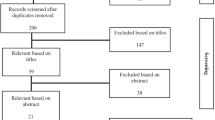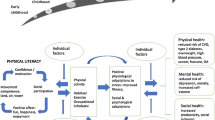Abstract
This study assessed the impact of automatically delivered stimulation on the activity level and mood (indices of happiness) of two students with multiple disabilities, during their use of a stationary bicycle and a stepper. The stimulation involved a pool of favorite stimulus events which were delivered automatically, through an electronic control system, while the students were active in using the aforementioned exercise tools. Data showed that stimulation had a positive impact on the overall level of activity and indices of happiness of both students. Practical implications and technical aspects of the intervention procedure are discussed.
Similar content being viewed by others
REFERENCES
Bennett, F., Eisenman, P., French, R., Henderson, H., and Schultz, B. (1989). The effect of a token economy on the exercise behavior of individuals with Down syndrome. Adapted Phys. Activity Q. 6: 230–246.
Caouette, M., and Reid, G. (1985). Increasing the work output of severely retarded adults on a bicycle ergometer. Educ. Train. Ment. Retard. 20: 296–304.
Caouette, M., and Reid, G. (1991). Influence of auditory stimulation on the physical work output of adults who are severely retarded. Educ. Train. Ment. Retard. 26: 43–52.
Crawford, M. R., and Schuster, J. W. (1993). Using microswitches to teach toy use. J. Dev. Phys. Disabil. 5: 349–368.
Favell, J. A., Realon, R. E., and Sutton, K. A. (1996). Measuring and increasing the happiness of people with profound mental retardation and physical handicaps. Behav. Interv. 11: 47–58.
Green, C. W., and Reid, D. H. (1996). Defining, validating, and increasing indices of happiness among people with profound multiple disabilities. J. App. Behav. Anal. 29: 67–78.
Lancioni, G. E., Gigante, A., O'Reilly, M. F., Oliva, D., and Montironi, L. (2000). Indoor travel and simple tasks as physical exercise for people with profound multiple disabilities. Percept. Motor Skills 91: 211–216.
Lancioni, G. E., and O'Reilly, M. F. (1998). A review of research on physical exercise with people with severe and profound developmental disabilities. Res. Dev. Disab. 19: 477–492.
Lancioni, G. E., O'Reilly, M. F., Campodonico, F., and Mantini, M. (2001). Promoting performance fluency in a person with profound intellectual disability and blindness. Behav. Cogn. Psychother. 29: 373–377.
Lancioni, G. E., O'Reilly, M. F., Singh, N. N., Oliva, D., and Groeneweg, J. (2002). Impact of stimulation versus microswitch-based programs on indices of happiness of people with profound multiple disabilities. Res. Dev. Disabil. 23: 149–160.
Miltenberger, R. (1997). Behavior Modification: Principles and Procedures, Brooks/Cole, New York.
O'Brien, Y., Glenn, S., and Cunningham, C. (1994). Contingency awareness in infants and children with severe and profound learning disabilities. Int. J. Disabil. Dev. Educ. 41: 231–243.
Siegel, S., and Castellan, N. J. (1988). Nonparametric Statistics, 2nd edn., McGraw-Hill, New York.
Silverthorn, K. H., and Hornak, J. E. (1993). Beneficial effects of exercise on aerobic capacity and body composition in adults with Prader-Willi syndrome. Am. J. Men. Retard. 97: 654–658.
Storey, K. (1996). Social validation issues in social skills assessment. Int. J. Disabil. Dev. Educ. 43: 167–174.
Thibadeau, S., Blew, P., Reedy, P., and Luiselli, J. K. (1999). Access to white bread as an intervention for chronic ruminative vomiting. J. Behav. Ther. Exp. Psychiatry 30: 137–144.
Author information
Authors and Affiliations
Corresponding author
Rights and permissions
About this article
Cite this article
Lancioni, G.E., Singh, N.N., O'Reilly, M.F. et al. Use of Simple Exercise Tools by Students with Multiple Disabilities: Impact of Automatically Delivered Stimulation on Activity Level and Mood. Journal of Developmental and Physical Disabilities 16, 171–178 (2004). https://doi.org/10.1023/B:JODD.0000026614.37905.eb
Issue Date:
DOI: https://doi.org/10.1023/B:JODD.0000026614.37905.eb




